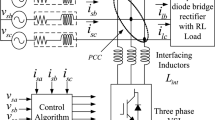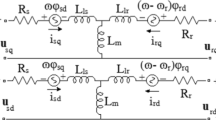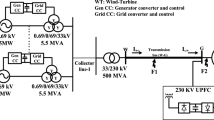Abstract
The paper proposes a complex domain control and robustness analysis approach to damping of Sub-Synchronous Control Interactions (SSCI) in the IEEE first and second benchmark models and is applied to wind farms with Doubly-Fed Induction Generators (DFIG). Two complex pole-placement control laws are proposed to eliminate oscillations at different levels of compensation as well as at varying speed conditions. The complex domain framework reduces the system dimensions by half and facilitates the direct placement of the system poles in the left-half plane, ensuring stability and performance. An observer is designed to estimate the variables that would be difficult to measure at a high sampling rate but are useful to stabilize the systems. Time-domain simulations in MATLAB/Simscape show that the proposed controllers are successful in eliminating oscillations. By leveraging a complex domain representation, the feedback system is analyzed as a single-input single-output (SISO) system. This simplifies the visualization of the robustness of the controllers and makes it possible to compute the gain, phase, and delay margins of the feedback system. These margins are validated in simulations on the full-scale model. The proposed complex pole-placement controller is then compared to other excitation control-based approaches to demonstrate its effectiveness.
Similar content being viewed by others
References
Y. Zhao, L. Ye, W. Wang, H. Sun, Y. Ju, and Y. Tang, “Data-driven correction approach to refine power curve of wind farm under wind curtailment,” IEEE Transactions on Sustainable Energy, vol. 9, no. 1, pp. 95–105, January 2018.
Z. Li, L. Ye, Y. Zhao, X. Song, J. Teng, and J. Jin, “Short-term wind power prediction based on extreme learning machine with error correction,” Protection and Control of Modern Power Systems, vol. 1, no. 1, pp. 1–8, June 2016.
Y. Zhao, L. Ye, Z. Li, X. Song, Y. Lang, and J. Su, “A novel bidirectional mechanism based on time series model for wind power forecasting,” Applied Energy, vol. 177, pp. 793–803, September 2016.
T. Ahmad, O. Coupiac, A. Petit, S. Guignard, N. Girard, B. Kazemtabrizi, and P. C. Matthews, “Field implementation and trial of coordinated control of wind farms,” IEEE Transactions on Sustainable Energy, vol. 9, no. 3, pp. 1169–1176, July 2018.
Y. Deng, Z. Xing, and Q. Zhang, “Analysis of electromagnetic transient characteristics of doubly-fed induction generator under grid voltage swell,” CPSS Transactions on Power Electronics and Applications, vol. 3, no. 2, pp. 111–118, June 2018.
H. Nian, T. Wang, and Z. Q. Zhu, “Voltage imbalance compensation for doubly fed induction generator using direct resonant feedback regulator,” IEEE Transactions on Energy Conversion, vol. 31, no. 2, pp. 614–626, June 2016.
R. Bhattarai, N. Gurung, S. Ghosh, and S. Kamalasadan, “Parametrically robust dynamic speed estimation based control for doubly fed induction generator,” IEEE Transactions on Industry Applications, vol. 54, no. 6, pp. 6529–6542, November/December 2018.
M. Popat, B. Wu, F. Liu, and N. Zargari, “Coordinated control of cascaded current-source converter based offshore wind farm,” IEEE Transactions on Sustainable Energy, vol. 3, no. 3, pp. 557–565, July 2012.
J. V. Lamy, P. Jaramillo, I. L. Azevedo, and R. Wiser, “Should we build wind farms close to load or invest in transmission to access better wind resources in remote areas? A case study in the MISO region,” Elsevier Energy Policy, vol. 96, pp. 341–350, September 2016.
H. A. Mohammadpour and E. Santi, “Modeling and control of gate-controlled series capacitor interfaced with a DFIG-based wind farm,” IEEE Transactions on Industrial Electronics, vol. 62, no. 2, pp. 1022–1033, February 2015.
B. Badrzadeh, M. Sahni, Y. Zhou, D. Muthumuni, and A. Gole, “General methodology for analysis of sub-synchronous interaction in wind power plants,” IEEE Transactions on Power Systems, vol. 28, no. 2, pp. 1858–1869, May 2013.
P. Li, J. Wang, L. Xiong, and M. Ma, “Robust nonlinear controller design for damping of sub-synchronous control interaction in DFIG-based wind farms,” IEEE Access, vol. 7, pp. 16626–16637, January 2019.
H. Liu, X. Xie, C. Zhang, Y. Li, H. Liu, and Y. Hu, “Quantitative SSR analysis of series-compensated DFIG-based wind farms using aggregated RLC circuit model,” IEEE Transactions on Power Systems, vol. 32, no. 1, pp. 474–483, January 2017.
W. Rui, S. Qiuye, M. Dazhong, and H. Xuguang, “Line impedance cooperative stability region identification method for grid-tied inverters under weak grids,” IEEE Transactions on Smart Grid, vol. 11, no. 4, pp. 2856–2866, July 2020.
A. Rygg, M. Molinas, C. Zhang, and X. Cai, “A modified sequence-domain impedance definition and its equivalence to the dq-domain impedance definition for the stability analysis of AC power electronic systems,” IEEE Journal of Emerging and Selected Topics in Power Electronics, vol. 4, no. 4, pp. 1383–1396, December 2016.
IEEE Committee, “Report first benchmark model for computer simulation of subsynchronous resonance,” IEEE Transactions on Power Apparatus and Systems, vol. 96, no. 5, pp. 1565–1672, September/October 1977.
IEEE SSR Working Group, “Second benchmark model for computer simulation of subsynchronous resonance,” IEEE Transactions on Power Apparatus and Systems, vol. 104, pp. 1057–1064, 1985.
A. E. Leon and J. A. Solsona, “Sub-synchronous interaction damping control for DFIG wind turbines,” IEEE Transactions on Power Systems, vol. 30, no. 1, pp. 419–428, January 2015.
P. Huong, M. S. El Moursi, W. Xiao, and J. L. Kirtley, “Subsynchronous resonance mitigation for series-compensated DFIG-based wind farm by using two-degree-of-freedom control strategy,” IEEE Transactions on Power Systems, vol. 30, no. 3, pp. 1442–1454, May 2015.
H. A. Mohammadpour and E. Santi, “SSR damping controller design and optimal placement in rotor-side and grid-side converters of series-compensated DFIG-based wind farm,” IEEE Transactions on Sustainable Energy, vol. 6, no. 2, pp. 388–399, April 2015.
M. Mokhtari, J. Khazaei, and D. Nazarpour, “Sub-synchronous resonance damping via doubly fed induction generator,” Electrical Power and Energy Systems, vol. 53, pp. 876–883, 2013.
L. Fan and Z. Miao, “Mitigating SSR using DFIG-based wind generation,” IEEE Transactions on Sustainable Energy, vol. 3, no. 3, pp. 349–358, July 2012.
M. Ghafouri, U. Karaagac, J. Mahseredjian, and H. Karimi, “SSCI damping controller design for series-compensated DFIG-based wind parks considering implementation challenges,” IEEE Transactions on Power Systems, vol. 34, no. 4, pp. 2644–2653, July 2019.
P. Li, J. Wang, L. Xiong, M. Ma, Z. Wang, and S. Huang, “Robust sub-synchronous damping controller to mitigate SSCI in series-compensated DFIG-based wind park,” IET Generation, Transmission & Distribution, vol. 14, no. 9, pp. 1762–1769, May 2020.
D. Suriyaarachchi, U. Annakkage, C. Karawita, and D. Jacobson, “A procedure to study sub-synchronous interactions in wind integrated power systems,” IEEE Transactions on Power Systems, vol. 28, no. 1, pp. 377–384, February 2013.
Z. Miao, “Impedance-model-based SSR analysis for type 3 wind generator and series-compensated network,” IEEE Transactions on Energy Conversion, vol. 27, no. 4, pp. 984–991, December 2012.
L. Fan, R. Kavasseri, Z. L. Miao, and C. Zhu, “Modeling of DFIG-based wind farms for SSR analysis,” IEEE Transactions on Power Delivery, vol. 25, no. 4, pp. 2073–2082, October 2010.
R. K. Varma, S. Auddy, and Y. Semsedini, “Mitigation of subsynchronous resonance in a series-compensated wind farm using FACTS controllers,” IEEE Transactions on Power Delivery, vol. 23, no. 3, pp. 1645–1654, July 2008.
M. S. El-Moursi, B. Bak-Jensen, and M. H. Abdel-Rahman, “Novel STATCOM controller for mitigating SSR and damping power system oscillations in a series compensated wind park,” IEEE Transactions on Power Electronics, vol. 25, no. 2, pp. 429–441, February 2010.
S. Gupta, A. Moharana, and R. K. Varma, “Frequency scanning study of sub-synchronous resonance in power systems,” Proc. of 26th IEEE Canadian Conference on Electrical and Computer Engineering (CCECE), Regina, Canada, pp. 1–6, May 2013.
H. Baesmat and M. Bodson, “Pole placement control for doubly-fed induction generators using compact representations in complex variables,” IEEE Transactions on Energy Conversion, vol. 34, no. 2, pp. 750–760, 2019.
H. Baesmat and M. Bodson, “Design of pole placement controllers for doubly-fed induction generators in the complex domain,” Proc. of IEEE Power & Energy Society General Meeting, Denver, CO, pp. 1–5, 2015.
A. Dòria-Cerezo and M. Bodson, “Root locus rules for polynomials with complex coefficients,” Proc. of 21st Mediterranean Conference on Control and Automation, Chania, Crete, pp. 663–670, 2013.
H. Baesmat and M. Bodson, “Suppression of sub-synchronous resonances through excitation control of doubly fed induction generators,” IEEE Transactions on Power Systems, vol. 34, no. 6, pp. 4329–4340, November 2019.
R. Gagnon, G. Turmel, C. Larose, J. G. Brochu, G. Sybille, and M. Fecteau, “Large-scale real-time simulation of wind power plants into hydro-québec power system,” Proc. of 9th International Workshop on Large-Scale Integration of Wind Power into Power Systems as well as on Transmission Networks for Offshore Wind Power Plants, Québec, Canada, 2010.
N. W. Miller, J. J. Sanchez-Gasca, W. W. Price, and R. W. Delmerico, “Dynamic modeling of GE 1.5 and 3.6 MW wind turbine-generators for stability simulations,” Proc. of IEEE Power Engineering Society General Meeting, Toronto, Canada, pp. 1977–1983, 2003.
A. Dòria-Cerezo, F. M. Serra, and M. Bodson, “Complex-based controller for a three-phase inverter with an LCL filter connected to unbalanced grids,” IEEE Transactions on Power Electronics, vol. 34, pp. 3899–3909, July 2018.
L. Harnefors, “Modeling of three-phase dynamic systems using complex transfer functions and transfer matrices,” IEEE Transactions on Industrial Electronics, vol. 54, pp. 2239–2248, July 2007.
M. A. Chowdhury and G. M. Shafiullah, “SSR mitigation of series-compensated DFIG wind farms by a nonlinear damping controller using partial feedback linearization,” IEEE Transactions on Power Systems, vol. 33, no. 3, pp. 2528–2538, May 2018.
Author information
Authors and Affiliations
Corresponding author
Additional information
Hana Jannaty Baesmat received her B.Sc. degree in electronic engineering and an M.Sc. degree in electrical engineering from the University of Kurdistan, Kurdistan, Iran, in 2007 and 2010, respectively, and a Ph.D. degree in electrical engineering from the University of Utah, UT, USA in 2019. Currently, she is a senior manager of the electrical engineering program management at Amazon RME, USA.
Marc Bodson received the Ingénieur Civil Mécanicien et Electricien degree from the Université Libre de Bruxelles, Brussels, Belgium, in 1980, two M.S. degrees, one in electrical engineering and computer science and one in aeronautics and astronautics, from the Massachusetts Institute of Technology, Cambridge, MA, USA, in 1982, and a Ph.D. degree in electrical engineering and computer science from the University of California at Berkeley, Berkeley, CA, USA, in 1986. Currently, he is a Professor of Electrical and Computer Engineering with the University of Utah, Salt Lake City, UT, USA. He was Chair of the Department of Electrical and Computer Engineering from 2003 to 2009. Prof. Bodson was the Editor-in-Chief of the IEEE Transactions on Control Systems Technology from 2000 to 2003. He was elected Associate Fellow of the AIAA in 2013.
Publisher’s Note
Springer Nature remains neutral with regard to jurisdictional claims in published maps and institutional affiliations.
Rights and permissions
About this article
Cite this article
Baesmat, H.J., Bodson, M. Complex-domain Design and Robustness Analysis for the Control of SSCI in DFIG-based Wind Farms. Int. J. Control Autom. Syst. 20, 483–495 (2022). https://doi.org/10.1007/s12555-020-0622-3
Received:
Revised:
Accepted:
Published:
Issue Date:
DOI: https://doi.org/10.1007/s12555-020-0622-3




